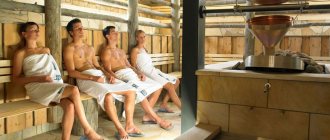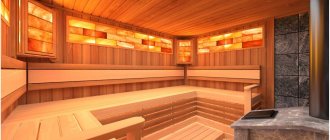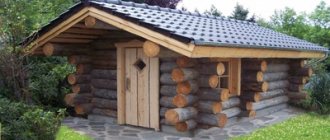Proper air exchange in the steam room is one of the main conditions for receiving pleasure and benefit from bath procedures. The desired effect can only be achieved with a well-thought-out and rationally placed ventilation system.
However, not all owners understand the technology of ventilation devices. As a result, there is not enough oxygen in the steam room, which leads to fatigue, weakness, rapid breathing, headaches and other problems associated with lack of air in steamers.
5/5 — (1 vote)
The need for ventilation in the steam room
Proper air exchange is necessary in any room. In a steam room, where temperature and humidity reach peak levels, its value increases significantly. Imagine a person locked in a confined space filled with clouds of wet steam.
If there is no well-thought-out ventilation system, oxygen quickly runs out, and there is no influx from the outside. After all, the doors are tightly closed to maintain the temperature. It is to preserve steam and temperature that inexperienced craftsmen tightly seal all the cracks into which air from the street can penetrate.
But such an approach can lead to negative consequences for the health of steamers and the internal condition of the room:
The concentration of carbon dioxide leads to disruptions in the functioning of the respiratory and cardiovascular systems.
High humidity leads to the formation of harmful fungi and bacteria on the walls, destroying them and causing an unpleasant odor.
A properly installed ventilation system solves both problems.
Thanks to its organization, the following is achieved:
- saturation of the steam room with oxygen.
- creating optimal bath processes for managing steam and air exchange.
- drying the bath after washing to prevent the formation of mold and fungi that destroy wooden structures.
Principles and main components of ventilation organization
The main condition that the ventilation system in the steam room must meet is ensuring effective air exchange. Fresh air must come from outside, displacing exhaust air. In this case, the hot steam should remain in the steam room.
When designing ventilation in a steam room, the requirements for it are simple:
- coolness should be concentrated near the floor, and heat should be concentrated near the ceiling;
- even temperature level, without fluctuations;
- “exhaust” air must be replaced with fresh, oxygen-enriched air.
For this purpose, they organize:
vents - supply openings that serve as channels for fresh air;
hoods are outlets through which heated, exhaust air leaves the bathhouse.
To achieve maximum efficiency of the ventilation process, experts recommend adhering to the following principles:
- locate the inlet openings as close to the stove as possible, and always near the floor;
- choose walls for placement of exhaust openings that are diametrically opposite to those on which the vents are located;
- do not place hoods under the ceiling;
- equip exhaust openings with special dampers or doors that allow you to control the air supply/exhaust.
To properly make ventilation, you need at least three holes:
- inlet – air flow;
- exhaust - gravity or forced - outflow of exhaust air;
- chimney.
Steam room design ideas
The arrangement of the steam room is not very diverse and has a classic interior, which consists of multi-level benches and a stove-heater.
The layout of the shelves should suit different needs and personal preferences. When using the room zoning option, you can line the stove with stone and install benches made of wood.
When decorating a steam room, a popular design solution is to install windows through which you can observe the surrounding landscape.
That's basically all you need to know if you are installing and decorating a steam room in a bathhouse yourself. The work is not difficult, but building for yourself is just a pleasure. The most important thing is to do everything correctly and not miss any detail, and in this case any bath procedure will bring health to the whole body and indescribable pleasure.
Vent size
When choosing the size of the exhaust opening, you must follow several rules:
- The largest one should be at the maximum distance from the stove so that the heat does not escape from the steam room in a direct flow.
- The remaining holes can be placed around the perimeter of the ceiling.
- The hole size is calculated based on 24 square meters. cm per cubic meter of room. Most often, the diameter does not exceed 30 cm, but the number is 2 or more.
- The traction force is determined by the height difference between the supply and exhaust openings.
IMPORTANT! Holes cannot be placed opposite each other. This will inevitably cause drafts in the steam room.
Types of ventilation
There are quite a lot of design options for organizing this kind of supply/exhaust systems, and there is simply no single, universal option acceptable for any room.
All existing systems according to their operating principle are divided into the following types:
Natural. Ventilation occurs due to the intake of street air, its mixing in the room and the natural displacement of exhaust air.
Forced. An additional device – a fan – is switched on. Most often it is installed on the hood, but it can also be installed on the inflow. A fan is used in each room of the bathhouse.
Combined - a symbiosis of the first and second options.
Scheme
Whatever the ventilation schemes in bathhouses, there is one general rule - the supply opening should be located at a height of 20-30 cm from the floor level, and the exhaust opening at the same distance, but from the ceiling.
A supply and exhaust system, which must meet several generally uncomplicated rules and conditions:
- The air in a steam bath of any design must be 100% renewed every 2-3 hours.
- It is better to place the inlet openings in close proximity to the heater, as well as at a small height from the floor.
To be able to regulate the inflow and outflow of air into the steam room, you need to close them with special dampers, which should open gradually, for example, move.
Holes for exhaust air removal are made on the opposite wall from the one where the supply air is located. Moreover, the higher they are placed, the stronger traction can be provided. But for a bathhouse this is not always the best solution, so it is important to correctly calculate the traction force.
Natural
This option is optimal for most baths, since it is cheap and at the same time quite effective.
The easiest way to obtain breathing air in a steam room is to place a small window next to the shelf and the door to the dressing room. The window and door are opened between visits during rest. Upon returning to the steam room, they close it and steam again.
To dry the steam room, make a small vent. Some install it in the far corner under the ceiling, others under the shelf. The placement of these holes must be determined based on the size of the room, the location of the heater and shelves, as well as the material from which the bathhouse is built.
Ventilation openings should be at the same level from the floor. Thus, the incoming air flows are heated from the furnace and rise upward, while the cooled ones fall down and enter the exhaust vents. To preserve heat in the steam room, the openings can be closed with dampers.
The dimensions of the vents should be approximately 300-400 sq/mm. If the air exchange is too rapid, which will cause a decrease in the temperature in the steam room, therefore, the degree of opening of the dampers must be adjusted.
Forced
In this scheme, the movement of air flows is carried out using fans installed in the ventilation openings. Installing fans allows you to quickly refresh the air. This option is well suited when a steam generator is installed in the bathhouse.
The forced exhaust system has a number of advantages over the natural one:
- it is possible to filter incoming air masses;
- maintaining a given microclimate;
- uniform distribution of heated air.
Expert opinion
Lovkachev Boris Petrovich
Bath master who knows everything about steaming
To allow large volumes of fresh air to enter the steam room, it is necessary that the ventilation openings be located diametrically to each other. When installing fans, you should not place the inlet and exhaust vents at the same level in order to prevent short-circuiting of air flows, which will cause a concentration of cooled air below, and it will be too hot above.
If the stove is not installed in a steam room, a different ventilation scheme is used:
- An inlet opening is made near the heating device at a height of 300 mm from the floor level.
- An exhaust opening is installed on the wall opposite it at a distance of 300 mm from the ceiling.
- Sometimes an inlet opening is made at the bottom of the wall behind the stove so that the air coming from the street is heated by the heater and the room cools down moderately.
- On the wall opposite the heating device, make 2 holes that will form a single exhaust duct. The first opening is located at a height of 1 m from the floor level, and the other is located under the ceiling.
With this ventilation scheme, the steam room warms up faster and, accordingly, fuel is saved.
Ventilation according to Bast
The system has gained wide popularity due to its ease of installation and efficient heat distribution.
The Bastu principle is an inverted glass:
- The supply and exhaust air ducts are at the same height - just above the floor level.
- The lower pipe through which air enters the steam room originates from the street, the outlet is located behind the stove - this is the draft.
- The heated air outlet is located diagonally from the oven, located below the bench. Warm air from the stove rises, creates increased pressure under the ceiling, and in the opposite corner it cools down and, falling, enters the ventilation.
The main difference is that the air temperature is approximately the same across the height of the room, whereas in a Russian bath the upper bench is hotter and the lower bench is more comfortable. When heated air masses rush to the lower point of the hood, they take heavy moist air with them and dry the floors faster.
The disadvantage of the ventilation system according to Bast is the dependence of effective operation on the strength of the wind on the street, when the air blown into the exhaust pipe interferes with the natural outflow, and worst of all, it can reverse it. Then the steam room will be filled with the smell of burnt fuel, which will not allow you to get the proper result from the procedures.
Ventilation valves
This is another ventilation scheme.
The influx occurs through the vents located in the lower part of the room, near the floor, and the removal occurs through a hole located at the top with ventilation valves installed in them. From the outside, the holes are connected by a common ventilation duct that rises to a certain height. The height of the lower exhaust valve is about 50-60 cm from the floor, and the upper one is 30-40 cm from the ceiling.
Floor
Now let's move on to the more practical part.
Here we have several options - two for wooden floors and one for ceramic floors. The poured wooden floor is made from ordinary boards, usually 40 mm thick, which are attached to the joists, and these, in turn, lie on brick pillars and on the foundation frame. However, here we are not talking about the construction of the floor inside and out.
We are only interested in finishing the floor with our own hands. In order to prepare the boards for fastening, they must be well planed on all sides. It’s good to go over it with a sander - the fewer irregularities, the less water will linger on the surface of the wood.
ATTENTION! Remember that the floor boards never touch the walls; a centimeter gap is required between the walls and the covering (it is usually covered with a plinth).
When attaching poured floor boards, you need to leave a gap of 4-10 mm between them. Actually, the gaps are the whole point. And it is advisable to leave a couple of boards unfastened so that you can monitor the underground space for the condition of the drain, the presence of debris, etc.
The most important thing when attaching boards to joists is that the fastener (a self-tapping screw, for example) should go into the joists at an angle of approximately 45 degrees. This is a guarantee of reliability.
A dry floor involves the use of tongue-and-groove boards, that is, having a tongue-and-groove joint. Such boards provide a tight fit that does not allow water to pass through. The flooring made of tongue and groove boards is attached to the joists in the same way as it was done in the previous case - the fasteners go into the joists at an angle of 45 degrees.
However, there is one difference - hidden fastening , which can be done through the groove either with finishing nails (without heads) or staples. It is also permissible to use clamps (if they do not rust), and they are also fastened with self-tapping screws, nails, and staples.
Ceramic tiles are laid on a concrete screed. First, you should do a test installation (not forgetting about the seams - insert crosses). This will determine how much material you need to cut.
- First you need to level the surface if it is uneven. A primer can be used for this purpose.
- The tile is prepared for laying by applying glue both to it and to the floor - two even thin layers of glue on both surfaces. On the floor, use a notched trowel, which must be moved at an angle of 60 degrees to the floor surface.
- The first row is laid out exactly with whole tiles against the wall opposite the entrance. If the wall is uneven, there is a bevel, then there is no need to fill it - lay it out along the guide, and the distance between the wall and the tile that increases during the process is then filled with cut pieces. This way you will get the correct geometry.
- The height of the tiles is leveled using a rubber hammer and a wooden block.
- Don't forget the crosses so that the seams are even. Later, the crosses are removed and the seams are filled with grout. Before grouting, at least 24 hours must pass, during which you cannot walk on the tiles! Before grouting, wipe the tiles with a damp cloth. The grout is applied with a rubber spatula, and the excess is removed after a few minutes with a sponge.
IMPORTANT! Grout is not used between the wall and the floor; there is an expansion joint there; it will not be visible under the baseboard; there is no need to fill it.
Selecting a type and pattern depending on the wall material
The ventilation system directly depends on the characteristics of the structure itself and the material of its walls. The bathhouse can be a separate room or adjacent to the house. The first option is much better. In such a bathhouse you can install the most economical ventilation option.
The bathhouse adjacent to the house must be dried in the most serious manner. This will protect all walls from rotting. For such a bathhouse, exclusively forced ventilation is used, taking into account the safety of the walls and supporting structures of a residential building.
The bathhouse’s ventilation ducts can be connected to the common ones or separately exit to the street through the roof or through the wall.
Depending on the wall material, experts advise choosing the following types and ventilation schemes:
In brick and frame baths, it is recommended to install ventilation ducts in the walls, leading them to the roof or higher. For inflow, an air duct is laid, a ventilation valve or vents are used in the foundation. It is imperative to supplement the vents with exhaust fans for better removal of exhaust air.
Due to the characteristics of this material, bathhouses made of aerated blocks are equipped with galvanized air ducts made from ready-made pipes. Sometimes a channel is made from galvanized sheets, giving them the appropriate shape and reliably sealing the joints. The ducts must run over the wall.
Natural forced ventilation is allowed in log baths. When the wood breathes, there are the necessary gaps between the logs, windows are provided in all rooms of the bathhouse, gaps from the floor to the bottom edge of the door are 2-3 cm, the construction of additional ventilation channels may not be necessary. But in order not to “drown the street”, it is advisable to provide valves or dampers in the vents.
Advice! When organizing ventilation in the steam room, avoid using plastic elements: corrugations, boxes, plugs. They cannot withstand high temperatures and will melt, releasing harmful substances and acquiring an unaesthetic appearance. Only wood can be used as plugs for vents or hatches, since metal can burn from heat or rust when exposed to moisture.
Salvo - an economical solution for ventilation
If you are not sure that you can correctly calculate the size of the entrances and exits of ventilation ducts or their location, you can use the long-tried “old-fashioned” method - burst ventilation in a Russian steam bath.
Its essence is to quickly ventilate with wide open windows and doors. They are opened for 1-2 minutes. For maximum effect, it is best to use opposite windows and doors.
The method does not require additional financial costs, since you use the elements that are in the bathhouse design.
IMPORTANT! Do not overdo it with ventilation, because you can make the bath too cold. The method is most suitable for Russian baths, which are heated in black.
How to properly take a steam bath for a woman?
For the fair sex, bath procedures are even more important than for men. They have a positive impact on different aspects of women's lives.
Women Health. Having started visiting the bathhouse, after some time a woman may be surprised to discover that in addition to a general improvement in her health, for example, her thrush has disappeared. No doctor’s prescriptions helped, but then suddenly she took it and went through with it. It turns out that this sore develops on a nervous basis. And the steam room is a kind of antidepressant and muscle relaxant. The very ritual of visiting it helps to escape from everyday worries and forget about problems for a while, and the combination of water and heat allows the body to relax and remove muscle blocks. At this time, lactic acid is removed from the body, which was precisely what kept the organs in a state of spasm.
Under the influence of bath factors, cystitis and other inflammatory diseases of the genitourinary area also recede. The bath is also indicated for varicose veins, from which women also often suffer. It helps strengthen blood vessels. And this is only about specific female diseases. And here you can treat your heart, osteochondrosis, and runny nose.
Feminine beauty. Here the bath operates in three directions:
- Cleanses the skin. Cosmetic products do this superficially, and the heat of the bath opens the pores and allows all impurities to come out. As a result, acne and pimples are defeated. In addition, the dead layer of the epidermis is exfoliated - the skin becomes soft, like a baby’s. Brooms help a lot in this process. They also provide the supply of nutrients. How to properly take a steam bath with a broom? The main condition is that it must be natural and “fresh”, and also made from the right wood. Birch, for example, relieves skin inflammation, and oak fights increased oiliness.
- Improves skin texture. Massage with brooms also helps fight cellulite. The skin also gains a healthy appearance thanks to moisture saturation. It is no coincidence that people said: “After the bath, like a poured apple, it glitters in the light.”
- Burns excess fat. You shouldn’t count on rapid weight loss, but the point is that with regular visits to the bathhouse, the weight decreases steadily, without returning to its original positions. This happens due to the acceleration of metabolic processes.
To avoid getting bored of steaming alone, take a friend with you
A woman's life. Bath procedures prepare for the performance of two main female functions: childbirth and breastfeeding. The elasticity of the ligaments is maintained, making childbirth easier and with virtually no tears. And expansion under the influence of high temperatures of the ducts in the mammary glands contributes to the constant presence of milk.
After the childbearing period is left behind, the bathhouse again comes to the aid of a woman, easing the course of menopause.
FAQ
Is it possible to organize air intake for ventilation from under the floor into the steam rooms?
You shouldn't do this for 2 reasons. Exhaust air with unpleasant odors flows underground, and its penetration back into the steam room is not desirable. In winter, it is recommended to close the underground, so the flow of fresh air is impossible.
Why not use the hole in the ceiling leading to the attic as ventilation?
This is fundamentally wrong. Moist, warm air flows from the steam room into the attic, causing the ceilings to quickly fail.
Isn’t it enough to periodically open the door to the steam room as ventilation?
This is ineffective. Humid air enters the adjacent room and is concentrated there, so the steam room is not actually ventilated. If you open the door from the rest room to the street, you will get a draft, which sharply reduces the temperature in both rooms and disrupts the soaring process.
I made a hole in the steam room with a diameter of 100 mm, there are no windows. Between passes I open the hole. Isn't this enough for ventilation?
Not enough. Calculate the volume of air that escapes through such an opening. Such ventilation is ineffective. Still, it is worth organizing a serious ventilation system.
Is it possible to use a ventilation duct in a steam room, inside of which there are electric motors for air suction?
To organize a ventilation system in a steam room, it is preferable to choose systems without the use of electric motors. Only a specialist can correctly calculate the power of the electric motors used. Such a system will not work very efficiently. In addition, if you do not turn on the electric motors while heating the bathhouse, then there is a chance of them overheating and failing.
Is it possible for pregnant women to go to the bathhouse?
Everyone knows how difficult it can be to bear a baby - it’s rare that an expectant mother does not complain about her health. Regular visits to a Russian bath (as well as a Finnish sauna) help to alleviate the condition: reduce swelling, get rid of headaches and relieve tension. However, it is allowed only from the second trimester of pregnancy, for regular visitors and without being in a hot steam room. It’s better to sit in the waiting room without exposing yourself to stress and the threat of miscarriage.
If there are contraindications, then you can feel the positive effects of the steam room in the waiting room
It is no coincidence that doctors prohibit bath procedures for pregnant women in the early stages. From hot air, the heart begins to work twice as fast (heart rate reaches 160 beats per minute), blood flow sharply increases, pressure rises, and blood vessels dilate. It would not be surprising if, under such difficult conditions, the body wants to reject the fruit that burdens it.
Well, when the first three most “unreliable” months have passed, doctors even recommend resuming trips to the bathhouse. After all, they are a good prevention of intrauterine fetal hypoxia and premature aging of the placenta. It goes without saying that in case of a complicated pregnancy (threatened miscarriage, placenta previa, high blood pressure), the gynecologist will not advise you to do this.
In the old days, women gave birth in the bathhouse. It was the most sterile place in the house. And the increased temperature at this moment (in contrast to the first months of pregnancy) was very opportune - it contributed to the expansion of the birth canal.
After childbirth, welcome here again for a speedy recovery. After three months, you can start taking your baby with you. Children really like the sauna atmosphere. It’s funny to watch the expression of complete delight in a little man who doesn’t seem to understand anything yet. He enjoys “communicating” with his peers, smiles widely and actively gestures.
Of course, he reacts very sensitively to his mother’s mood. If she shows with all her appearance how wonderful it is here - it’s warm, you can splash around in the water, swim, the baby will follow her example. Otherwise, he will begin to worry, begin to be capricious, and cry. You should not take your child to the bathhouse if he is sick, has not had enough sleep, is hungry, or, conversely, has eaten too much.
It's good if there is a swimming pool nearby. Children really like water procedures. They feel there as if they were in their mother’s tummy, from where they just recently came out. And this helps them go through the process of adaptation to the unfamiliar world around them in a softer, more gentle form.
When going to the bathhouse with your baby, you should definitely stock up on the pediatrician’s recommendations, and you should start the procedure in just a few seconds.










